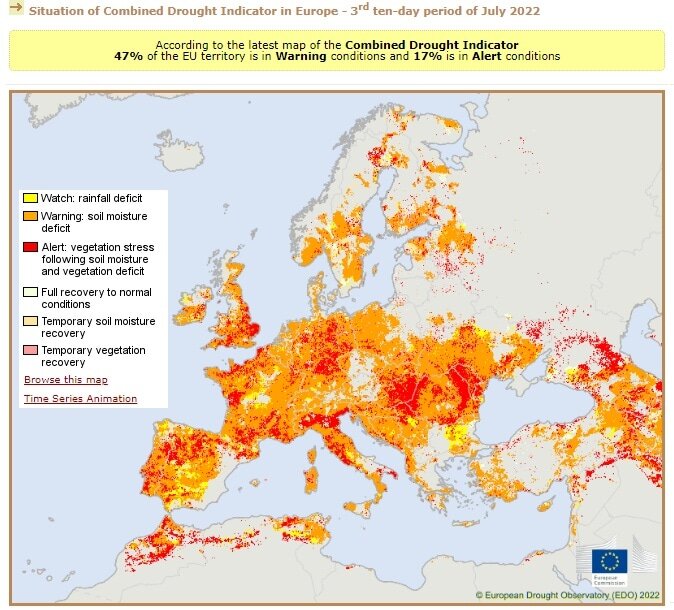Has Europe actually faced socio-economic drought?

TEHRAN- This dry summer coupled with Russian gas cuts has put water resources in an alarming situation across Europe.
According to the European Drought Observatory, almost half of Europe is experiencing a severe drought. France, Germany, Spain, Portugal, Italy, the Netherlands, Norway and the UK are among the countries that have been exposed to the high levels of drought. It is predicted this critical situation may be worsening if the precipitation deficit continues until winter.
Recently, a map referring to “combined drought indicator in Europe within 3rd ten-day period of July” went viral and conveyed the message that the green continent has faced a severe climate-driven drought in the last 500 years.
The currently rainfall deficit is mostly attributed to a weakened jet stream bringing moisture from Atlantic to Europe, combined with frequent heatwaves hitting all around the planet and Europe. Findings of a study (2020), as well as the Intergovernmental Panel on Climate Change (IPCC) reports, indicate that drought in west of Europe has not shown a consistent trend regarding precipitation deficit over the years 1851-2018. In addition, the intensity of agricultural drought (soil moisture level) and the hydrological drought (runoff rate and groundwater level) have not changed. Besides, the precipitation rate has not decreased much compared to previous years. In general, countries located in eastern and central Europe have been less affected by drought; the IPCC reports even demonstrate that drought severity has been reduced in Northern and Eastern Europe. So why is the anthropogenic drought has been highlighted and received more news coverage, particularly in Germany, France, the UK, the Netherlands, and Norway? Why are major rivers from Rhine to Danube drying up, ship traffic banned along the rivers and the water level of the reservoirs fallen at lowest levels ever? Is the situation climate-driven or result of a socio-economic drought?
Most of water restrictions were generally applied in residential and not business or other economic or agricultural sectors. By looking at the bans, one can gauge the emergency of the condition. For example, in France, water consumption in residential and business sectors are being accurately monitored by authorities. In Spain, too, restrictions have been put on residential sector; and there is a possibility, tourism sector will be also affected if the drought continues. Nevertheless, people believe that almost 90 percent of water resources go to agriculture, therefore, the water resources management must have been focused on that. The UK, however, declared hosepipe ban last week although the business sector not being included. While the UK average precipitation were reported 34.7mm in June 2018- when Europe was seeing a severe drought- and 38.6mm in the 1976, it was 59.0 mm in June 2022. There are two options left to explain the situation since the green continent is naturally having high levels of water. Moreover, Europe is famous for better performance in terms of water resource management than other countries in the world. First, the occurrence of extreme events, explicitly heat waves causing the climatic change attracts more attention; and second, the water-energy-food nexus leading into a socio-economic drought due to the Russian gas cuts.
At the moment, the Europe is struggling with energy crisis, too. According to the International Energy Agency (IEA), the global coal demand rose to 8 billion tons in 2022, matching the 2013 all-time high. Besides, the 14 percent jump in coal consumption over the last year, the European Union demand for coal climbed another 7 percent in 2022. The Union of Concerned Scientists (UCS) reports that “a typical coal-fired power plant employing a once-through cooling system withdraws 70?180 billion gallons of water every year and consumes 0.36-1.1 billion gallons of it”. Previously, the Guardian addressed the problem as well, identifying coal-fired power plants as one of the main causes of water loss, aside from being the main factor driving up global warming.
The economic-social drought, often interpreted as "water bankruptcy", refers to a state in which water regime and human activities mutually affect one another. And even beyond that, climate patterns. This is why the water-energy-food nexus has been the centre of attention in policy-making debates to adopt the most suitable strategies.
Leave a Comment